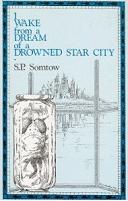 Jan Lars Jensen is a Canadian writer, Shiva 3000 was his first published novel - a very promising debut, too. Since its publication in 2000 he has not published any further works of fiction (although one website mentions that he has apparently written another novel), but has instead released a book charting his experiences/battle with mental illness (Nervous System: or, Losing My Mind In Literature), which might well explain the lack off follow-up. And I hope that this situation will change in the years to come, as I'd love to hear more from this writer!
Jan Lars Jensen is a Canadian writer, Shiva 3000 was his first published novel - a very promising debut, too. Since its publication in 2000 he has not published any further works of fiction (although one website mentions that he has apparently written another novel), but has instead released a book charting his experiences/battle with mental illness (Nervous System: or, Losing My Mind In Literature), which might well explain the lack off follow-up. And I hope that this situation will change in the years to come, as I'd love to hear more from this writer!
Shiva 3000 is playing in a future world (it never specifies exactly when, but the 3000 in the title provides a strong hint) and in a regressed, post-high civilization India, a lot of which we recognize, frequently in slightly warped form.
After an introduction which tells the story of a group of Buddhist visitors (missionaries?) to India, and the first appearance of the Baboon Warrior (a national hero with the head of a Baboon) we meet Rakesh, our main protagonist. We find him in the town of Sholapur, which is just about to be destroyed by the Jagannath, a huge, war-machine like (mechanical) god mounted on a giant chariot, which was called in by Brahmins to restore moral order. There he meets Vasant, the former (?) Royal Chief Engineer, who has betrayed his Sovereign by sleeping with the First Wife (it's all a Kamasutran plot, he insists). Together, unwillingly (at least on the part of Vasant) they travel this India, guided by Rakesh's dharma (he believes that it's his holy duty to kill the Baboon Warrior) and Vasant's urge for revenge.
The world they travel in shows remains of an earlier, high(er) civilization which has, at least partially, been lost. There are cities below today's, ie Sholapur has layers and layers of 'Old Sholapur' beneath its streets and houses; the new cities were simply build 'overtop', no further explanation is provided on the why, when, and how.
There are cars and lorries which run on dung bricks (of which there are different grades available – a fascinating econonmy in itself). And then there are the animated God-machines like the Jagannath; it is suggested that all the Hindu Gods, as they walk the earth, are machines, generally with human crew which is completely subsumed into the working of the machine.
The randomness of the road trip Rakesh and Vasant undertake shows off a large vairety of societal settings, sects, and systems of belief and goveranance. A lot of things they see, events they witness, and people/groups they meet are connected, with threads running under the surface of what is displayed. It is never made clear if this is an artefact of Rakesh's rather strong dharma, or if the entire world this plays in is interconnected like that. We also never really get an answer of where the dividing line lies (presuming there is one) betweeen the inextricably intertwined strands of science, magic, deism, philosophy, and personal belief. Think about it, the gods (which intereact with humans, and affect their dharma and Chakras) are machines, originally built by humans, and crewed by humans who work as an extension of the machine, or like a hive mind. Where is the line? Is there one? Or is it all part of the same thing, and we (or, respectively, me) simply cannot see it?
The random travels of the protagonists, and the unusual settings, people, and groups they meet occasionally reminded my of Pynchon – this is high praise indeed, given that he is the best author in the world, in my book! Er.
There were things that didn't gel, or I didn't like. There seems to be a split, a dichotomy in regards to violence and force, the impact thereof, and the overall destructive power of the Jagannath (although belief might of course play a role here). The book, or rather the author, is also inconsequent when it comes to suffering and death; in some cases people are important, so it is shown close-up and explored and discussed and explained – in other cases, with characters which only serve as background, or who are on the fringes, these things are dealt with (and dealt out) in scores, casually, and without further meaning. Yes, it could be a signifier for karma, but personally I do/did not think so.
Despite these weaknesses I cannot recommend this book enough – it's set in a fascinating and colourful world, and deals with concepts a lot of SF normally doesn't, and it does it with panache and style. More, please, if this isn't asking too much!
More Jan Lars Jensen
Title: Shiva 3000
Author: Jan Lars Jensen
Reviewer: Markus Thierstein
Reviewer URL: http://thierstein.net
Publisher: Macmillan
Publication Date: 2000
Review Date: 110417
ISBN: 0333780817
Price: UKP 9.99
Pages: 326
Format: Trade Paperback
Topic: Future History













